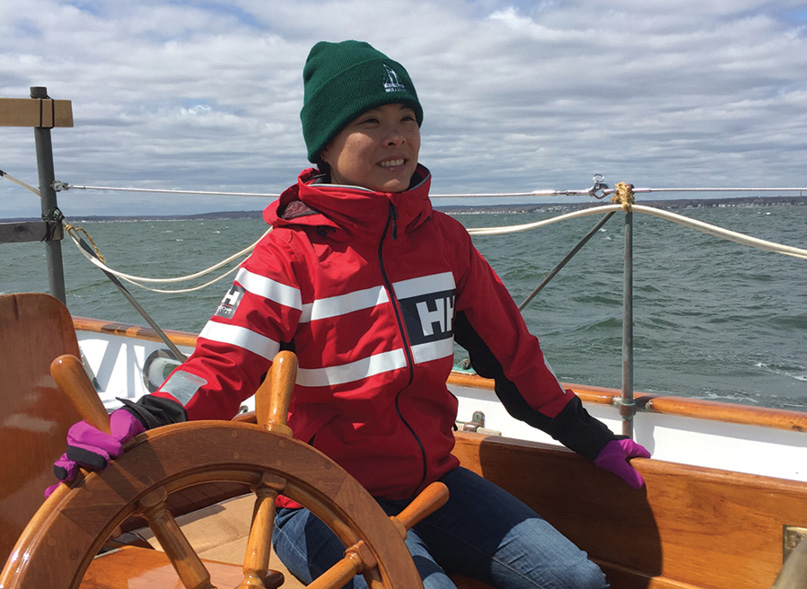 Novelist, maritime writer, photographer, artist, drummer and professional mariner Ger Tysk says reading the definitive book on the subject of whaling changed the course of her life.
Novelist, maritime writer, photographer, artist, drummer and professional mariner Ger Tysk says reading the definitive book on the subject of whaling changed the course of her life.
“I was born in the Chicago area and grew up in Texas,” says Ger (whose name is pronounced ‘jair’ like ‘chair’ and ‘tisk’ as in ‘Tsk, tsk’). “I wasn’t exposed to many on-the-water activities while growing up, and certainly not to maritime history. In school in Texas, we learned about the Alamo, but nothing about sailing and certainly not the history of whaling.”
Ger earned her B.A. in English Literature at the University of Texas at Austin. Returning to the U.S. after a few years in Japan, she was working as a librarian when she discovered Melville’s masterpiece. “When I read Moby-Dick,” she says, “I wasn’t just hooked by the adventure story of sailing around the South Pacific and literary element. I was also astounded that I had never heard of the whaling industry, which was such an important industry to the young United States.”
“After reading Moby-Dick, I decided I wanted to learn everything I could about tall ships and U.S. maritime history. I began by making trips to Boston, New Bedford, and Mystic Seaport Museum in Mystic, Connecticut and connecting with the history there. I eventually fell in love with New England and moved to Massachusetts, where I began sailing for the first time on the Charles River with Community Boating. I learned the basics of small boat sailing before I began sailing on tall ships.”
“I am a true hawsepipe sailor, which means I worked my way up the ranks after starting as a lowly deckhand,” says Ger, who holds a U.S. Coast Guard 200-ton Mate’s license and USCG Able Seaman endorsement. “I spent time with Mystic Seaport Museum, working three summers as cook and deckhand on the classic wooden Sparkman & Stephens schooner Brilliant, and Sea Education Association (SEA) in Falmouth, Massachusetts, where I started as a deckhand and eventually became a senior chief
steward.”
“In 2008, Mystic Seaport Museum undertook a massive restoration of the Charles W. Morgan, the last wooden whaleship in the world. The multi-year, multi-million dollar project culminated in a voyage around various New England ports in the summer of 2014. As the Morgan had sailed 37 voyages before her retirement in 1921, this would be her 38th. I applied, and was accepted to her ‘Voyager’ program, which brought together artists, writers, scientists, and other members of the arts and education community to chronicle the voyage in our own ways. Sailing on the Morgan was my first time on a tall ship.”
Ger completed her first transatlantic voyage in the fall of 2014, aboard SEA’s 134-foot brigantine Corwith Cramer. “The ship crossed from the Canary Islands, off the coast of Africa, to the island of Dominica in the Caribbean, and then worked her way north, ending her trip in the U.S. Virgin Islands. I came on board as a first-timer, not quite knowing what I was getting into and not realizing what a commitment it was to sign on for a transatlantic crossing. It was certainly a rite of passage, and there are definitely some ‘brownie points’ for you in the tall ship community if you’ve sailed a transatlantic, but I knew none of that at the time. The experience of being underway for two weeks out of sight of land, without internet, and without even much contact from cargo ships or airplanes, was a transformative one.”
Ger is the Marine Operations Associate with Oliver Hazard Perry Rhode Island, a Newport-based non-profit education foundation whose flagship (and Rhode Island’s Tall Ship) is the 200-foot, full-rigged Oliver Hazard Perry. “I primarily support the ship as the marketing coordinator, webmaster, and head of social media,” she explains. “I’m in charge of our day-to-day online presence, as well as all of our branding, graphics, signage, and merchandise. I also head up the ship’s volunteer program. During the winter, when we do not have our seasonal sailing crew on board, I act as the winter mate and make sure that our winter liveaboard crew is supported in their tasks. As an experienced ship’s steward, I also coordinate galley operations during the season.”
“I have written several books, both fiction and nonfiction, about New England maritime history and Japanese culture,” says Ger (GLTysk.com). “Although it seems that these two subjects don’t have much in common, I have been inspired since the beginning of my sailing journey by the story of John Manjiro, the first Japanese person to live in the United States and the subject of my book Nothing But An Island.”
“Working full time on a tall ship, it’s difficult to find time to write, but I’ve been grateful to have such photogenic subjects. Photographing tall ships is a rewarding endeavor, especially since I’m able to use my photography directly to support organizations that I love. When I’m not sailing, I work as the director of the Japanese taiko drumming ensemble ShinDaiko. Japanese drumming is not only a good way to connect with the local Asian-American community, it’s a great full body workout too.”
Looking forward to her next voyage, Ger relishes “the freedom of being in a wide open space, surrounded only by the sea and the sky and a small group of people you care about and who care about you so deeply that you would trust them with your life. Out on the ocean, it is just you, your shipmates, and your ship. It’s a true community that feels like family, one that is increasingly hard to find anywhere in our modern world. The biggest thing on my sailing bucket list is to round the Horn on a tall ship!” ■
